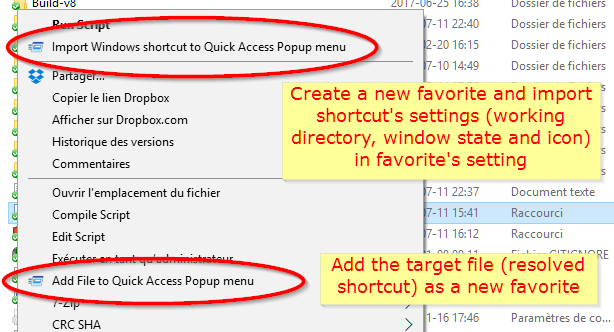The FileSelectFile has an option to retrieve the shortcut .lnk file itself instead of the target of the shortcut:
https://autohotkey.com/docs/commands/FileSelectFile.htm32 [v1.0.43.09+]: Shortcuts (.lnk files) are selected as-is rather than being resolved to their targets. This option also prevents navigation into a folder via a folder shortcut.
My question: I am using the Explorer Context menu to add files or folders to my app. I am using the SendMessage/OnMessage commands. When I receive a file or folder from the Explorer Context menu using this technique, I always get the target file (the "resolved" file). How could I get the shortcut .lnk file itself?
If this can help, here is samples from my code:
1) This is the sample code from the .reg file used to set Explorer context menus in registry:
Code: Select all
;--------------------------------------
; ADD FILE
;--------------------------------------
[HKEY_CLASSES_ROOT\*\shell\Add File to Quick Access Popup menu]
@="Add File to Quick Access Popup menu"
"Icon"="\"C:\\Program Files\\Quick Access Popup\\QuickAccessPopup.exe\""
[HKEY_CLASSES_ROOT\*\shell\Add File to Quick Access Popup menu\command]
@="\"C:\\Program Files\\Quick Access Popup\\QAPmessenger.exe\" AddFile \"%1\""
;--------------------------------------Code: Select all
;-----------------------------------------------------------
Send_WM_COPYDATA(ByRef strStringToSend, ByRef strTargetScriptTitle) ; ByRef saves a little memory in this case.
; Adapted from AHK documentation (https://autohotkey.com/docs/commands/OnMessage.htm)
; This function sends the specified string to the specified window and returns the reply.
; The reply is 1 if the target window processed the message, or 0 if it ignored it.
;-----------------------------------------------------------
{
VarSetCapacity(varCopyDataStruct, 3 * A_PtrSize, 0) ; Set up the structure's memory area.
; First set the structure's cbData member to the size of the string, including its zero terminator:
intSizeInBytes := (StrLen(strStringToSend) + 1) * (A_IsUnicode ? 2 : 1)
NumPut(intSizeInBytes, varCopyDataStruct, A_PtrSize) ; OS requires that this be done.
NumPut(&strStringToSend, varCopyDataStruct, 2 * A_PtrSize) ; Set lpData to point to the string itself.
strPrevDetectHiddenWindows := A_DetectHiddenWindows
intPrevTitleMatchMode := A_TitleMatchMode
DetectHiddenWindows On
SetTitleMatchMode 2
SendMessage, 0x4a, 0, &varCopyDataStruct, , %strTargetScriptTitle% ; 0x4a is WM_COPYDATA. Must use Send not Post.
DetectHiddenWindows %strPrevDetectHiddenWindows% ; Restore original setting for the caller.
SetTitleMatchMode %intPrevTitleMatchMode% ; Same.
return ErrorLevel ; Return SendMessage's reply back to our caller.
}
;-----------------------------------------------------------Code: Select all
;------------------------------------------------------------
RECEIVE_QAPMESSENGER(wParam, lParam)
; Adapted from AHK documentation (https://autohotkey.com/docs/commands/OnMessage.htm)
;------------------------------------------------------------
{
global g_strAppNameText
global g_strAppVersion
global g_strNewLocation
global g_strTargetClass
global g_strTargetWinId
intStringAddress := NumGet(lParam + 2*A_PtrSize) ; Retrieves the CopyDataStruct's lpData member.
strCopyOfData := StrGet(intStringAddress) ; Copy the string out of the structure.
StringSplit, arrData, strCopyOfData, |
; arrData1 contains the command (AddFile, AddFolder, etc.)
; arrData2 contains the target (the file or folder added)
if InStr(arrData1, "AddFolder") and (SubStr(arrData2, -1, 2) = ":""") ; -1 extracts the 2 last characters
; exception for drive paths
arrData2 := SubStr(arrData2, 1, StrLen(arrData2) - 1) . "\"
if (arrData2 = "C:""")
arrData2 := "C:\"
if (arrData1 = "AddFolder")
{
g_strNewLocation := arrData2
Gosub, AddThisFolderFromMsg
}
else if (arrData1 = "AddFile")
{
g_strNewLocation := arrData2
Gosub, AddThisFileFromMsg
}
else
return 0
return 1
}
;------------------------------------------------------------
